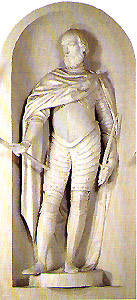
Cav. Proc. Giorgio Cornaro (B-29)
Born: 1454, Venice
Married: 1475, Elizabeth Morosini
Died: 31 July 1527, Venice
CAV. PROC. GIORGIO CORNARO, perhaps the preeminent figure in the long history of the Cornaro family, represented a nexus of political, economic, military and religious power. He was a paramount leader of Venice in periods of triumph and deadly peril. Although he was never elected Doge, he was honored with the accolade padre della patria [father of the country].
The skillful and daring diplomacy and trading skills of Giorgio's father Cav. Marco Cornaro (B-16) and his uncle Proc. Andrea Cornaro (B-17) had already carried the family to a new pinnacle of wealth and political prominence by arranging the 1468 marriage of Giorgio's sister Queen Caterina Cornaro (B-31) to James II Lusignan, King of Cyprus, thereby reenforcing and extending the Cornaro family's concessions in Cypriot sugar and salt production. Giorgio's first great public success came in 1489 when, at the behest of Venice's Council of Ten, he sailed to Cyprus with a military squadron under the command of Francesco Priuli. Giorgio's task was to convince his sister, who had become sole ruler of Venice following the death of the King and their young son, to renounce her throne in favor of Venice. Queen Caterina acceded to Giorgio's diplomacy and returned to Venice, leaving Venice with sole dominion of Cyprus, its last and greatest overseas territory.
His diplomatic success brought Giorgio honor, prestige, and a succession of important diplomatic and military posts. He was immediately honored with the title Cavaliere della Stola d'Oro. He served as Podestà [governor] at Brescia, 1496, and later as Capitano [military commander] at Verona. In 1901 he led diplomatic negotiations with the King of France and Emperor Maximilan. He served as a member of the Council of Ten in 1499, 1503, and various times between 1513 and his death in 1527.
Ultimately, his greatest service to the Republic may have been in waging war and winning peace. As Provveditore General in Terraferma [civil commander of the military forces on the mainland], Giorgio met with great success in repulsing the forces of the Emperor advancing toward Venice from the north through Friuli. Soon he was reappointed to a new term as Provveditore in Campo in the face of one of the most serious military challenges in the history of the Republic. The Papacy and the smaller states of the Italian penninsula joined forces with the Holy Roman Empire, Hungary, France and Spain as the "League of Cambrai" and assembled a combined military power to move against Venice's forces in Lombardy. Giorgio was at Brescia when he learned that Venice's army, led by mercenary commanders, had been decisively defeated at Agnadello, opening the way for an advance against Venice itself.
Giorgio organized the defense of Brescia and then returned himself to Venice to assist in coordinating Venice's long, patient and ultimately successful diplomatic campaign to mollify the members of the League and prompt its dissolution.
A portrait of Cav. Proc. Giorgio Cornaro by Titian was commissioned and hung in the meeting chamber of the Maggior Consilio [Grand Council] in the Doge's Palace. The painting was destroyed in the disastrous fire that struck the chamber in 1577. Giorgio himself commissioned Giovanni Maria Falconetto to create a funeral monument for Queen Caterina and other family members in the transepts of the Church of S. Salvatore, but the commission was never performed. (The family monuments there were later executed by Bernardo Contino at the end of the 16th century.)
Giorgio purchased from the Malombra family the Cà Cornaro on the Grand Canal in S. Maurizio Parish, which after Giorgio's death was destroyed by fire and replaced by the present Sansovino-designed palace.
© 1997 C. I. Gable
